Believe it or not, I ended up visiting Samarkand 4 times in my two-and-a-half-month mostly solo trip in Central Asia. Every time I visited, I managed to find something interesting to do in Samarkand. So, here’s an ultimate 3-day Samarkand itinerary to make the best of your visit to this ancient cultural capital of the world.
- Where to Stay in Samarkand
- About Samarkand
- Do you need a Guide to Explore Samarkand?
- Best Samarkand Itinerary
- Day 1: Visit the most popular attractions: Gur-i-Amir Complex, Registan Square, Bibi-Khanym Mosque
- Day 2: Admire the stunning turquoise tilework at Shah-i-Zinda and expand your Samarkand knowledge by visiting historical landmarks
- Day 3: Explore the artistic side of Samarkand & Shop for Souvenirs
- Vegetarian Restaurants in Samarkand
- How to Reach Samarkand
- Traveling Within Samarkand
- Frequently Asked Questions About Traveling to Samarkand
Transport to this magical town through this video:
Where to Stay in Samarkand
Accommodation Name | Stars | Price | Book |
- | $$ | ||
$$ | |||
$$ | |||
$$ | |||
$$$ | |||
$$$ |
Budget (20 USD & below)
Registan Hostel – I’ve stayed in the Registan hostel many times as I traversed through Uzbekistan. It’s clean, the rooms are spacious and quite convenient. Registan Hostel is perhaps the best hostel in Samarkand. All-in-all great service and friendly English-speaking staff. The only problem that I have is that it doesn’t offer breakfast. But then there’s a sandwich place right opposite the hostel for 1.5 USD which is great!
➜ Check prices of Registan Hostel
Optimist Guesthouse – This is a homestay with an inner courtyard with a garden surrounded by rooms on either side — one side where the family lives, and another side where the guests stay. The only downside is the location – the main attractions are around 5kms away. So you either need to hail a taxi or use local transport.
The host Iskandar (70+ years old) is such a warm and hospitable host who also happens to speak English as he stayed in different corners of the world. He has many stories to share from his life and it’s a pleasure to talk to him.
➜ Check prices of Optimist Guesthouse
Mid-range (30 USD & above)
Jahongir Hotel – One of the best-rated hotels in Samarkand. 9.1 rating on booking.com with around 700 reviews. Friendly staff, comfortable rooms, excellent location, and tasty breakfast. This hotel was highly recommended by a few friends that I met in Samarkand.
➜ Check prices of Jahongir Hotel
Shaxzoda Elite Hotel – If you are willing to splurge a little, then this is one of the top luxury hotels you can stay in Samarkand. Beautiful interiors with comfortable rooms. It also features an in-house spa and massage services.
➜ Check prices of Shaxzoda Elite Hotel
Luxury (100 USD & above)
Hilton Garden Inn Samarkand – With a perfect blend of modern comfort and historic charm, this Hilton hotel offers a relaxing stay amidst the ancient wonders of Samarkand. With its convenient location, upscale amenities, and a touch of local elegance, it’s a sanctuary for travelers exploring this timeless Silk Road city.
➜ Check prices of Hilton Garden Inn Samarkand
Samarkand Regency Amir Temur – This is a brand new 5-star hotel in Samarkand with lots of facilities and excellent breakfast. There’s also a spa in the hotel. Extremely clean rooms and attentive staff. Everything you expect from a 5-star hotel.
About Samarkand
Before we start with the itinerary, let’s orient ourselves with Samarkand first.
Samarkand is an ancient city located in the heart of Uzbekistan, and it is known for its rich history, stunning architecture, and its local bread.
Previously known as Maracanda in the 4th century BCE, it was the capital of Sogdiana. It’s estimated that Samarkand is about 2700 years old, as old as Rome.
This city was sought after by many emperors. It was conquered by Alexander the Great, destroyed by Genghis Khan, and rebuilt to its current grandeur by Amir Timur, who turned Samarkand into its imperial capital.
Most of the monuments in Samarkand are from the Timurid dynasty. The majority of it was built by the founder of the Timurid dynasty – Amir Timur himself.
In this blog post, you can find an easy-to-follow 3-day itinerary to Samarkand. But what if you have just a day and want to cover the top attractions of Samarkand? Then you can book this full-day private tour with an English-speaking guide.
On that note, here are some popular things to do in Samarkand:
Do you need a Guide to Explore Samarkand?
I don’t think it’s mandatory to travel with a guide and it’s possible to travel independently in Samarkand. But I’d highly recommend hiring a guide at least for the major tourist attractions as it helps understand the history and the monuments better.
1 Day Tours
Here are 2 tours that I recommend for a 1-day tour of Samarkand.
Budget-Friendly Option
➜ Visit 4 major attractions in Samarkand (limited to 20 people)
Time-Efficient Option
➜ Visit 9 attractions in Samarkand (Lunch & Entrance Fee included)
2-Day Tours
If you are looking for a 2-day guided tour of Samarkand, then check out this tour. It covers the major tourist attractions in one day and they also take you outside the city where you experience the real local life.
➜ Check out the prices of a 2-day guided tour of Samarkand.
Best Samarkand Itinerary
Day 1: Visit the most popular attractions of Samarkand: Registan Square, Gur-i-Amir Complex, Bibi Khanym mosque.
Day 2: Admire the stunning turqoise tilework at Shah-i-Zinda, and expand your knowledge about Samarkand by visiting these attractions: Islam Karimov Memorial, Hazrat Khizr Mosque, Afrasiyab Settlement, Ulugbek Observatory, and Tomb of Saint Daniel.
Day 3: Explore the artistic side of Samarkand & shop for souvenirs by visiting the Samarkand Bukhara Silk Carpets Factory, Paper Making Factory, Pottery Making Workshop, and Siab Bazaar.
Day 1: Visit the most popular attractions: Gur-i-Amir Complex, Registan Square, Bibi-Khanym Mosque
Let’s get acquainted with Samarkand. All of these attractions are walkable. So, even if you are staying away from the city center, you can either take a cab or a marshrutka (local minibus) to Amir Timur Mausoleum and you can follow this itinerary.
Amir Timur Mausoleum Gur-i Amir Сomplex
This mausoleum is the final resting place of Amir Timur, the founder of the Timurid dynasty who made Samarkand his capital and built some of the stunning monuments here.
If it wasn’t clear already, Amir Timur is part of the national identity of Uzbekistan and a national hero. This is quite surprising because, in Iraq, Iran, Pakistan, and India, the same Amir Timur is vilified for having massacred 100s of thousands of people.
If the name Amir Timur rings a bell, that’s because he is the great-great-great grandfather of Babur – the one who established the Mughal Empire in the Indian subcontinent.
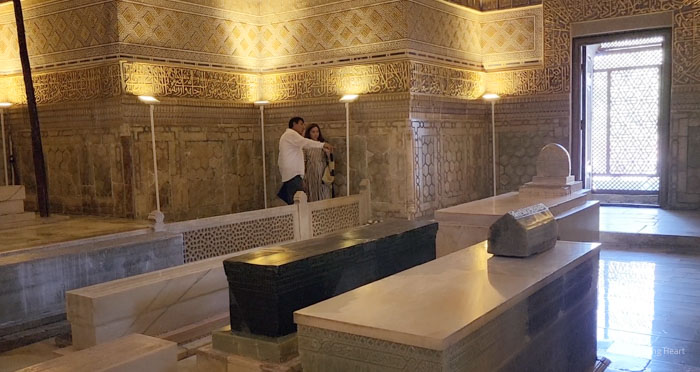
Timur’s coffin reads: “Whoever opens my tomb shall unleash an invader more terrible than I”.
And there’s an interesting story surrounding it which involves Hitler no less.
Curse of Timur’s Tomb
In 1941, Joseph Stalin sent a team of archaeologists to open Timur’s tomb in Samarkand, Uzbekistan, much to the alarm of local residents.
Two days later, Hitler’s troops invaded Russia. It doesn’t end here. Let’s call this co-incidence no. 1.
By the end of 1942, Stalin finally ordered Timur’s remains to be returned to his tomb in Samarkand. About a month later, the Soviets defeated the Nazis at the battle of Stalingrad turning the course of WW2. And that’s co-incidence no. 2.
Whether there is some truth in it or not, this story is now a legend and one that you’ll hear of when in this mausoleum.
Entry Fee: 20,000 UZS (USD 2)
Visit the heart of Samarkand – Registan Square
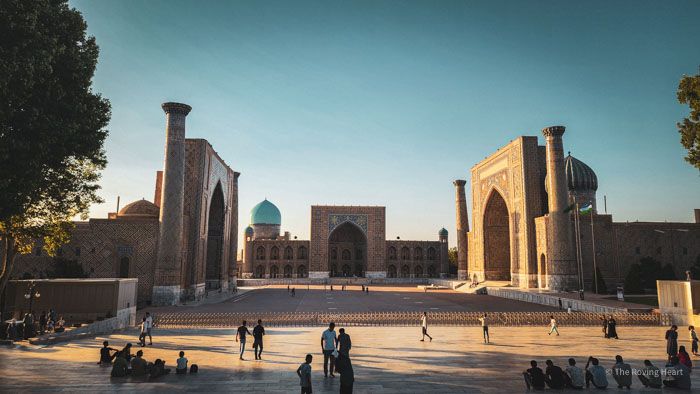
Something that you just cannot miss when in this ancient city is Registan Square – the heart of Samarkand.
Registan Square was once a noisy and bustling bazaar. And where caravanserai (roadside inns) existed to cater to merchants and travelers traveling along the Silk Road. Who were probably the world’s foremost travelers! Silk Road stories always conjure images of mysticism and wonder, doesn’t it?
Now it has 3 imposing structures – intricately decorated madrasas which are essentially universities built in the 15th and 17th centuries. Ulugh bek, Tilla Kari, Sher Dor madrassah. In Islamic Architecture, you are not allowed to draw animals & people. That’s why you see abstract art everywhere in Islamic Architecture.
Inside these madrassahs, you’ll find a lot of rooms on the ground and the first floor. The ground floor rooms were initially classrooms and the upper floor hosted sleeping quarters for the students.
Now each of these are flanked by souvenir shops.
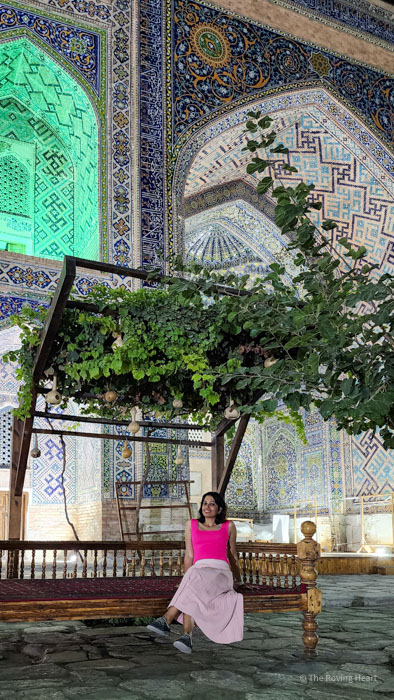
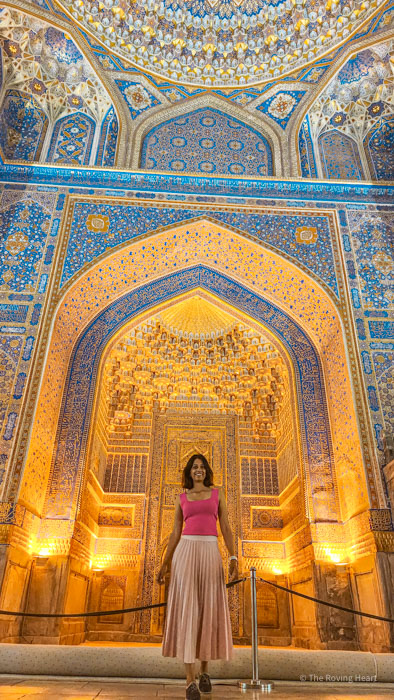
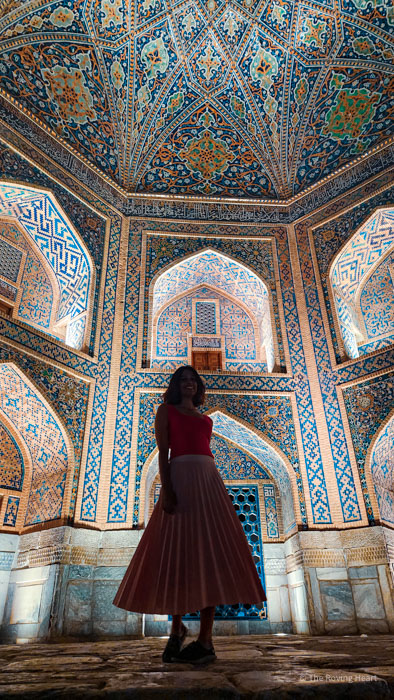
Ulugbek Madrassah
It was built in the 15th century under the direction of Ulugbek, a ruler who valued the arts and sciences. This madrassah is the oldest one among the three madrassahs here.
The madrassah is known for its distinctive blue dome, intricate patterns, and ornate exterior. The interior is divided into four courtyards and includes classrooms and dormitories for students. It once housed 200 students studying science, mathematics, astronomy, among others.
Tilla-Kari Madrassah
This madrassah houses a mosque which is one word – stunning! It’s really hard to encapsulate how dazzling and glorious the interiors are. But let me tell you this – the blue and gold interiors will enrapture you. It’ll perhaps be unlike anything you’ve ever seen before. At least, that was the case for me.
Sher Dor madrassah
On the top of the facade of Sher Dor Madrassah, you’ll find roaring lions. This is the only structure that is an exemption from the otherwise abstract art that’s ubiquitous in the Islamic Architecture of Samarkand. Along with the lion and the deer, the Mongolian-faced sun is said to have been inspired by Zoroastrian architecture.
An artist who owns a souvenir shop explained that the lion chasing the deer represents the pursuit of knowledge. The lion is the student and deer represents knowledge and the sun is the teacher. Quite apt for a center of learning, isn’t it?
Entry Fee: 50,000 UZS (USD 5)
Do you need to hire a Guide while Visiting Registan Square?
You can hire an English-speaking guide outside the madrassah for 50,000 UZS. But this option may not always be available, especially during low season or off-peak hours or if you are short on time. So, you can pre-book a guided tour for the major attractions of Samarkand.
Travel Tips for Visiting Registan Square
- You can visit Registan Square in the morning or evening. I suggest visiting a few hours before sunset so you can experience Registan Square during the evening and when it’s lit up. I’d recommend 5-6 pm to visit the square.
- Watch the light show that happens every night at 9 pm.
- The entry fee is valid only for 1 entry inside Registan Square. So make sure you’ve at least 3 hours to spare before you enter the square.
- For an additional 50,000 UZS, a local person can take you to the top of the tower. But this is not entirely legal, it’s more hush-hush. I’ve heard some people going for this option. If you do, please note that the steps leading to the top can be too narrow at times, and can squeeze in only 1 person. Probably not a good idea if you are claustrophobic. I didn’t go for this option, however.
Bibi-Khanym Mosque
Built in the 15th century, this mosque was one of the largest and most magnificent mosques in the Islamic World. According to Wikipedia, Bibi-Khanym mosque was one of the most ambitious architectural projects of the Timurid period and influenced the architecture of Central Asia as well as of Iran and Afghanistan.
This stunning architectural masterpiece is known for its massive size and grandeur, with four towering minarets and a massive dome that rises above the main prayer hall. The interior of the mosque is equally impressive, with intricate tilework and ornate decorations adorning the walls and ceiling. Despite undergoing several renovations and restorations over the centuries, the Bibi-Khanym Mosque remains a popular tourist attraction and an important cultural and religious site for the people of Samarkand.
Day 2: Admire the stunning turquoise tilework at Shah-i-Zinda and expand your Samarkand knowledge by visiting historical landmarks
While the first 3 monuments – Islam Karimov Memorial, Shah-i-Zinda, and Hazrati Hyzer mosque can be covered on foot, you’ll have to take a taxi to Ulugbek Observatory.
Islam Karimov Memorial
The Islam Karimov Memorial in Samarkand is a tribute to the late president of Uzbekistan, who played a significant role in the country’s modern history. It features a bronze statue of Islam Karimov, surrounded by lush gardens and fountains.
Visitors can learn about Karimov’s life and accomplishments through exhibits and displays within the memorial. Despite his controversial tenure as the president who ruled a repressive authoritarian regime, Karimov is remembered as a strong leader who helped to modernize and develop Uzbekistan. The Islam Karimov Memorial serves as a reminder of his impact on the nation and is a testament to his enduring legacy.
Hazrat Khizr Mosque
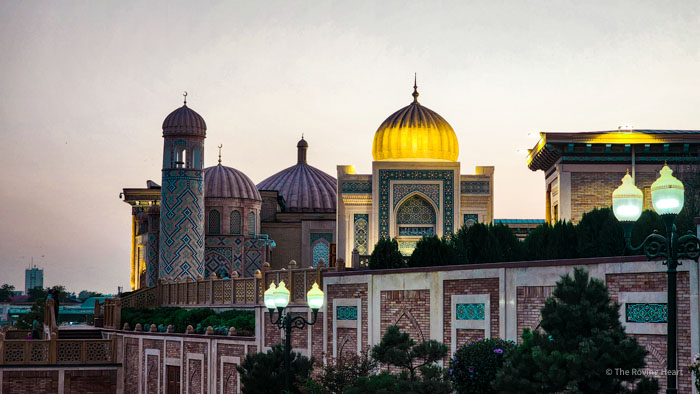
It was built in the early 15th century and is named after the revered Sufi saint Hazrati Hyzer. The mosque is known for its ornate architectural style, with beautiful blue tiles adorning the exterior and intricate geometric patterns covering the walls and dome. Inside, the mosque is spacious and airy, with a large central prayer hall and several smaller chapels.
Marvel at the Stunning Shah-i-Zinda Mausoleum Complex
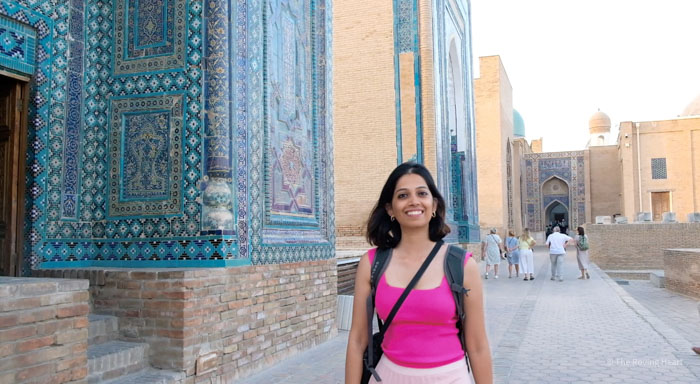
This necropolis (mausoleum complex) contains some of the richest tilework in Central Asia.
The name, Shah-i-Zinda which means ‘Tomb of the Living King’, refers to the innermost and holiest shrine claimed to have belonged to Qutham b. ‘Abbas, a cousin of Muhammad. Stories.
Various temples, mausoleums, and buildings were continually added throughout the ensuing centuries, from approximately the 11th century to the 19th.
You’ll find mausoleums for Amir Timur’s wives, sisters, and important members of the royal family from the Timurid Era.
As a result, Shah-i-Zinda is one of the oldest and longest-running examples of a continually constructed historic site in the world.
By the way, did you notice? There’s a lot more turquoise in this part of the world.
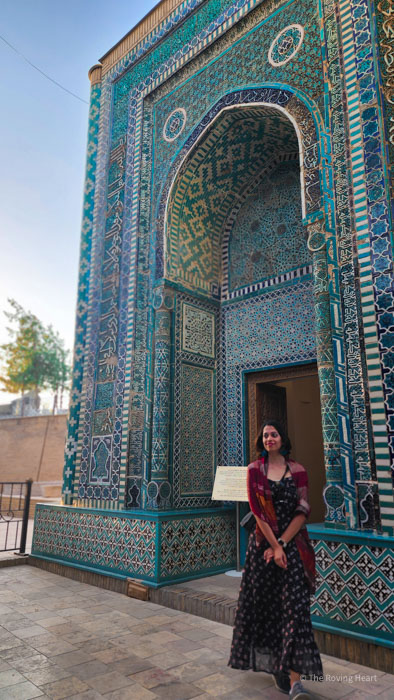
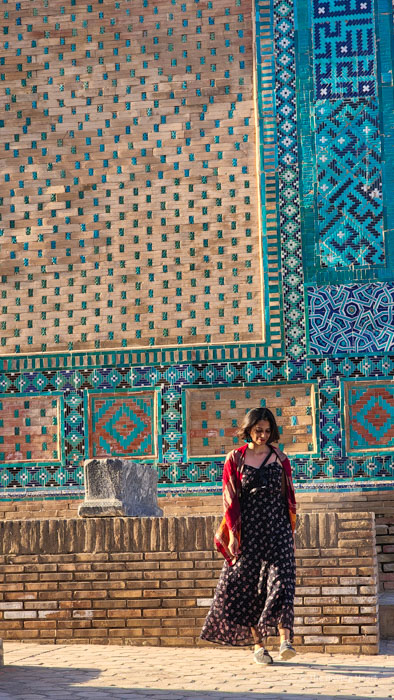
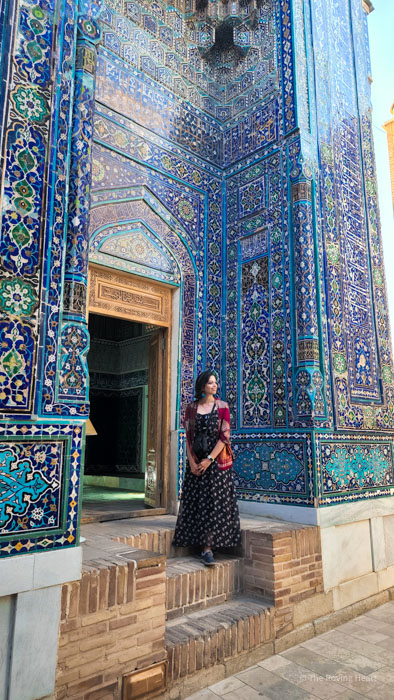
Shodi Mulk Oko Mausoleum
Considered one of the most beautiful buildings in the complex. This was built in 1372 in honor of Timur’s sister Turkon Oko and her daughter Shodi Mulk Oko. You can find this second on the left after the entry stairs. Notice the exquisite majolica and terracotta work when you are here.
Samarkand’s Controversial Monument Restoration
A lot of monuments in Samarkand including this one went through restoration starting from the Soviet Rule.
Many of these tombs here were controversially restored and apparently, a lot of liberties were taken and it’s said that the brilliant tilework is unlike the original one.
Nevertheless, this is Samarkand’s most beloved site and is worthy of a visit.
Afrasiyab Settlement
The Afrasiyab Settlement in Samarkand, Uzbekistan is a significant historical site that dates back to the pre-Islamic period. It is believed to be the ancient city of Marakanda, which was founded in the 7th century BCE by the Sogdians, a Central Asian civilization.
The settlement was later conquered by Alexander the Great and eventually became part of the Persian Empire. The Afrasiyab Settlement is known for its impressive ruins, which include a citadel, a palace, and several temples.
It is also home to a number of ancient artifacts, including ceramics and textiles, that offer insights into the life and culture of the people who lived there.
Today, the Afrasiyab Settlement is a popular tourist destination and a UNESCO World Heritage Site.
Ulugbek Observatory
The Ulugbek Observatory in Samarkand is a historical landmark built in the 15th century by the famous astronomer and mathematician, Ulugbek. The observatory was a major center for scientific research and education in the region, and it played a significant role in the development of astronomy and mathematics in the Muslim world.
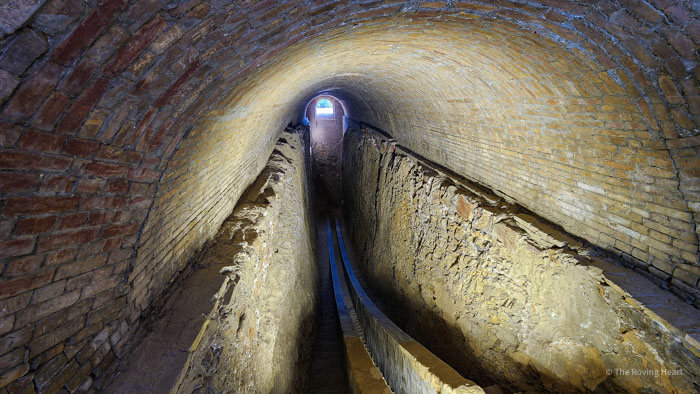
The observatory was equipped with advanced instruments, including a sextant and a quadrant, which were used to make precise measurements of the stars and planets. It is a testament to the intellectual and scientific achievements of Ulugbek and the people of Samarkand.
Right next to the observatory, you can find a museum where visitors can learn about the history of science and see the remnants of the observatory’s instruments.
What I found particularly fascinating here is that there’s a notebook in the museum with coordinates of over 1000 stars marked in it.
Entry Fee: 20,000 UZS (USD 2)
Tomb of Saint Daniel
The tomb is believed to be the burial place of Daniel, a biblical prophet and saint who is revered by both Muslims and Christians. The tomb is in a beautiful garden, surrounded by trees and flowers. Visitors can pay their respects to Saint Daniel by visiting the tomb and praying at the site. Many people believe that the tomb has special powers and that it can bring good luck and blessings to those who visit it. The Tomb of Saint Daniel is a popular destination for tourists and pilgrims, and it is an important part of the cultural and religious heritage of Samarkand.
The tomb is about 1.2 km from the observatory so it can be covered on foot.
Day 3: Explore the artistic side of Samarkand & Shop for Souvenirs
So far, we covered the popular tourist sites in Samarkand. On our last day in Samarkand, let’s delve a little deeper into the fabric of Samarkand and also indulge in some souvenir shopping!
Take a taxi from the carpet factory to the paper factory and then visit the ceramic workshop on foot.
Samarkand Bukhara Silk Carpets Factory
This is the most popular carpet factory in Samarkand where you’ll find the most luxurious handmade silk carpets. Whether you planning to buy a carpet or not, I’d highly suggest visiting this factory.
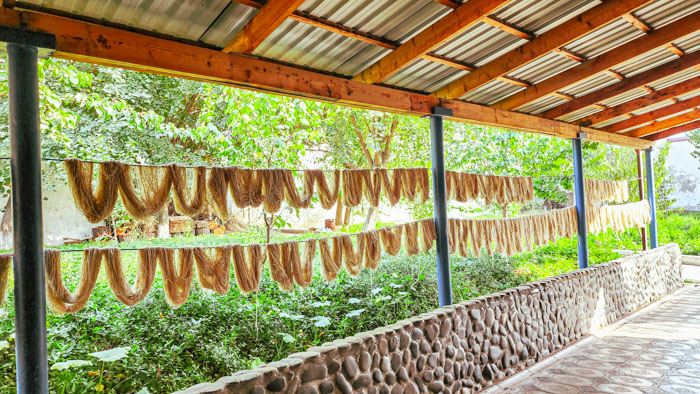
Every visitor to this Silk Carpet Factory is offered a tour guide who provides an in-depth look at the intricate process behind the creation of these luxurious handmade carpets. From the use of natural dyes to skilled knitting techniques, you’ll have the opportunity to witness the true craftsmanship and labor that goes into each and every carpet. The factory tour is educational, providing visitors with a greater understanding of the cultural and historical significance of these beautiful carpets.
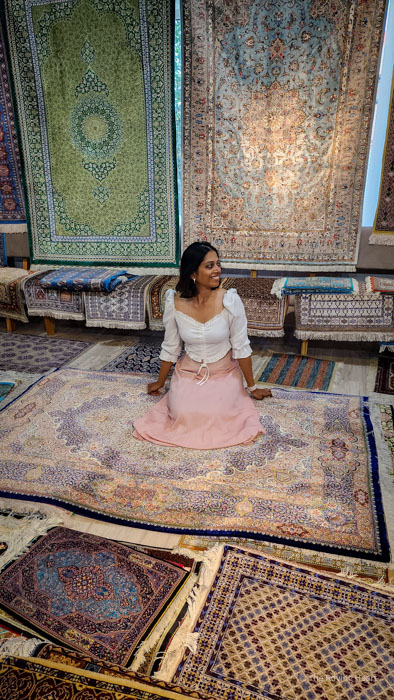
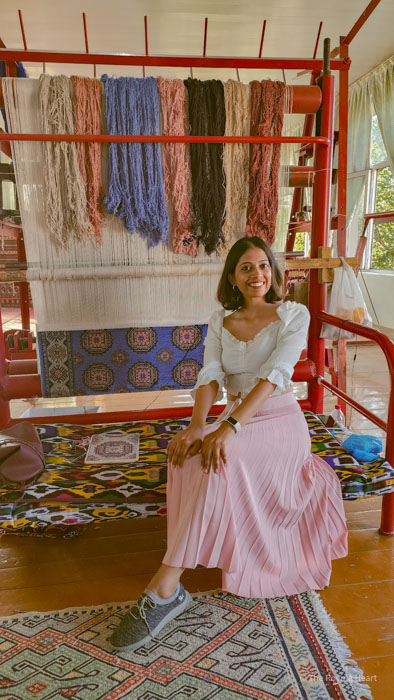
Most of the carpets here are priced USD 500 and above. The most expensive carpet here is priced at USD 15,000. Phew!
And for those like me, who may not be able to afford the high price tag of a handmade carpet, there are also affordable silk scarves available for purchase (USD 20 and above). Overall, the Samarkand Bukhara Silk Carpets Factory is a unique and fascinating attraction that offers a glimpse into the world of traditional carpet-making.
Paper Making Factory
This factory offers visitors the opportunity to learn about the ancient art of paper-making. While China is the birthplace of paper making, there’s an important place in the history books reserved to paper making in Samarkand.
This factory is home to a team of skilled craftsmen who use traditional techniques to create high-quality handmade paper.
The process begins with the preparation of the raw materials, which include cotton and other natural fibers. These fibers are then soaked, beaten, and transformed into a pulp, which is used to create the paper.
Visitors can watch the entire process from start to finish, and even have the chance to try their hand at paper-making themselves. In addition to paper, the factory also produces other handmade products such as notebooks and greeting cards as souvenirs for tourists.
Entry Fee: 20,000 UZS (2 USD)
Pottery Making Workshop
I only stumbled across this place by chance but one that I would highly suggest visiting.
This place offers visitors the opportunity to learn about the art of pottery-making and purchase handmade souvenirs crafted by a skilled father-daughter duo.
Located just a short 5-minute walk from the Paper Making Factory, this workshop is a perfect addition to a day of exploring the artisanal traditions of Samarkand.
In addition to browsing the selection of pottery and other handmade items available in the workshop’s store, visitors can also participate in a hands-on pottery-making experience, learning the techniques and skills needed to create their own pieces of ceramics.
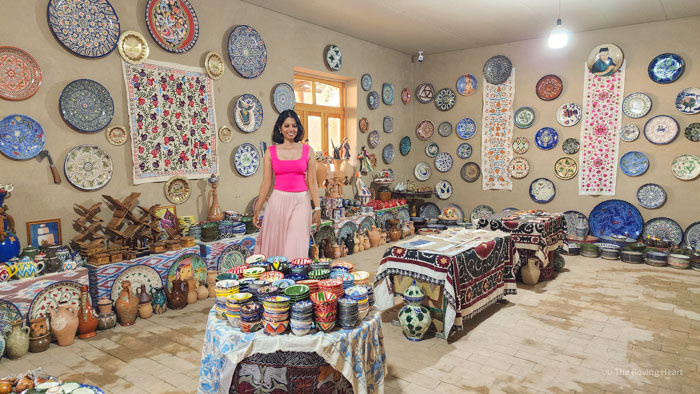
Whether you’re interested in purchasing a one-of-a-kind souvenir or trying your hand at pottery-making, I have a feeling that you’ll enjoy visiting here.
Siab Bazaar
Visit Samarkand’s most popular and largest bazaar – Siab Bazaar. It’s a vibrant and bustling marketplace known for its rich history and cultural significance.
The bazaar is home to a variety of stalls and vendors selling everything from fresh produce and spices to traditional crafts and clothing. The atmosphere at Siab Bazaar is lively and colorful, with merchants calling out to attract customers and the sound of haggling filling the air.
In addition to its shopping and culinary offerings, the bazaar is also a great place to immerse oneself in the local culture and meet the friendly and hospitable people of Samarkand. Whether you’re looking to pick up souvenirs or simply enjoy the sights and sounds of the bazaar, Siab Bazaar is a must-see destination in Samarkand.
Signup for a Local Wine Tasting Tour
If you have more time, then you could try the local wine.
Did you know that wine-making is popular in Samarkand? Sign up for a wine-tasting tour in Samarkand to discover the rich heritage of Uzbek wine. Immerse yourself in a two-hour tasting adventure at Khovrenko Winery and appreciate the flavors that make Uzbek wine renowned in Central Asia. The tour also covers pickup and drop-off which is convenient. Sip, savor, and unravel the culture and history!
➜ Check prices for Wine Tasting Tour
Vegetarian Restaurants in Samarkand
Central Asia is a highly meat-eating region, so it might be challenging to find vegetarian food, especially outside the tourist areas. I ended up visiting Samarkand 4 times and every time, my yearning for good vegetarian food only grew stronger. So I was on a hunt to find the best vegetarian places in Samarkand. And these are my personal favorites:
Oasis Garden
You’ll find good vegetarian food right on the menu – something you’ll notice is hard to come by, especially outside the tourist areas in Uzbekistan. Vegetarian Pasta and the pizza here are quite decent. And for dessert, don’t miss out on the classic cheesecake that will make your taste buds sing. This restaurant is on the expensive side for Samarkand, but one of the top restaurants for vegetarian food.
Restaurant Karimbek
One of the hottest local spots in Samarkand. While the vegetarian options were limited here, I enjoyed the savory pumpkin soup and the irresistible potato starter. But the real star of the show is the mouthwatering onion bread that will have you coming back for more.
Bibikhanum Teahouse
Located steps away from the Bibi Khanym mosque, this restaurant is styled like a traditional Central Asian teahouse, or “chaykhana” as they call it in Uzbekistan.
From the rustic decor to the warm ambiance, this restaurant has a whole different vibe. And don’t leave without sampling the local dishes here. Try their signature pumpkin manti, a hearty dumpling dish that is sure to satisfy your appetite. This is a must-visit destination for anyone looking to experience the true essence of Uzbekistan.
How to Reach Samarkand
Most tourists arrive in Samarkand either from Tashkent from the east or Bukhara from the west. The primary mode of transportation between cities in Uzbekistan is through trains.
Try the Afrosiyob (the fast train that runs at 200kmph) when in Uzbekistan. I’m sure it’s going to surprise you how amazing these trains are! Book your tickets through the UZ Railway app at least a month in advance if you are visiting during the season time. If you want a last-minute guaranteed pass for Afrosiyob, then buy it through Viator.
Traveling Within Samarkand
Yandex
The taxis in Uzbekistan are quite budget friendly – about 2$ for about 5kms. And the fastest and most hassle-free option to go around in Samarkand is to avail of the services of a taxi-hailing app – Yandex.
Download the Yandex app before traveling to Uzbekistan and you’ll be able to use it in different cities in Uzbekistan, including Samarkand.
Local Taxi
I have frequently utilized the local taxi option in Samarkand, particularly when staying outside the city and wishing to visit popular tourist destinations such as Registan or Shah-i-Zinda. This option is a shared taxi service, and I was charged 5,000 som (approximately 50 cents) per seat for a distance of 4-5 kilometers. The only inconvenience I experienced was the difficulty in identifying when a local taxi was passing by. However, I found that by signaling with my hand along the side of the road, taxis were willing to stop.
Marshrutkas
The marshrutka, or shared minibus, is a cost-effective means of transportation within the city. This mode of transport is primarily used by locals. To ensure a smooth experience, it is recommended to consult with a local host or a local friend to determine the locations of stops and the appropriate marshrutka to board, as language barriers may present a challenge.
Frequently Asked Questions About Traveling to Samarkand
And that brings us to the end of this blog post. Happy traveling in the ancient city of Samarkand. If this blog post helped you plan your trip, then tag me on Instagram @therovingheart and let me know! I’d be a happy puppy!
Uzbekistan Checklist
Everything you need to know about traveling to Uzbekistan is in this exhaustive guide.
Like it? Pin it!
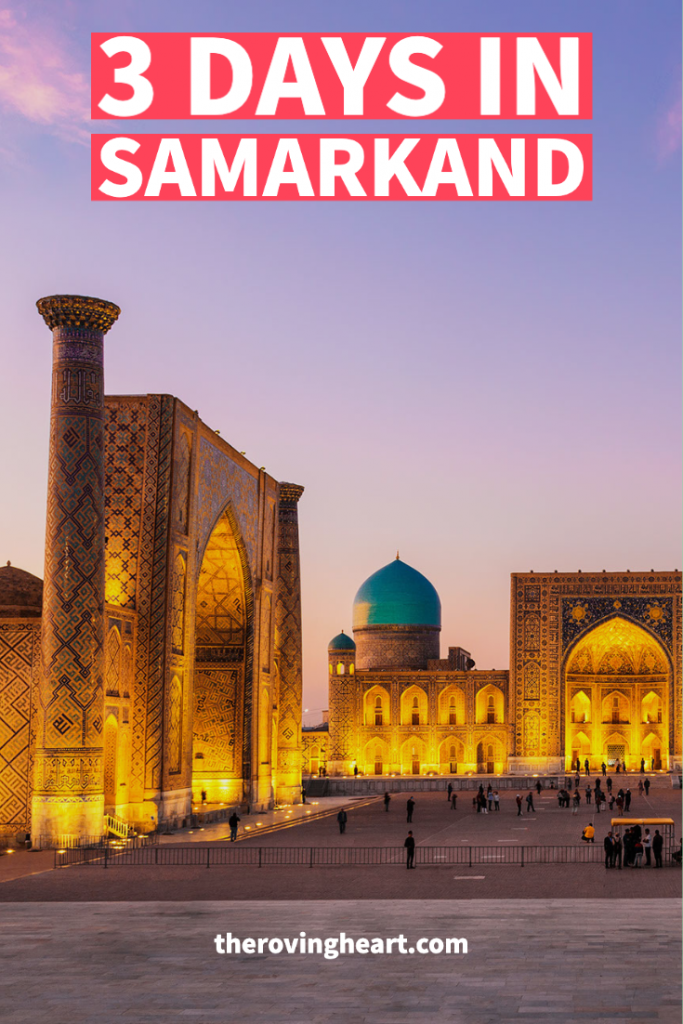
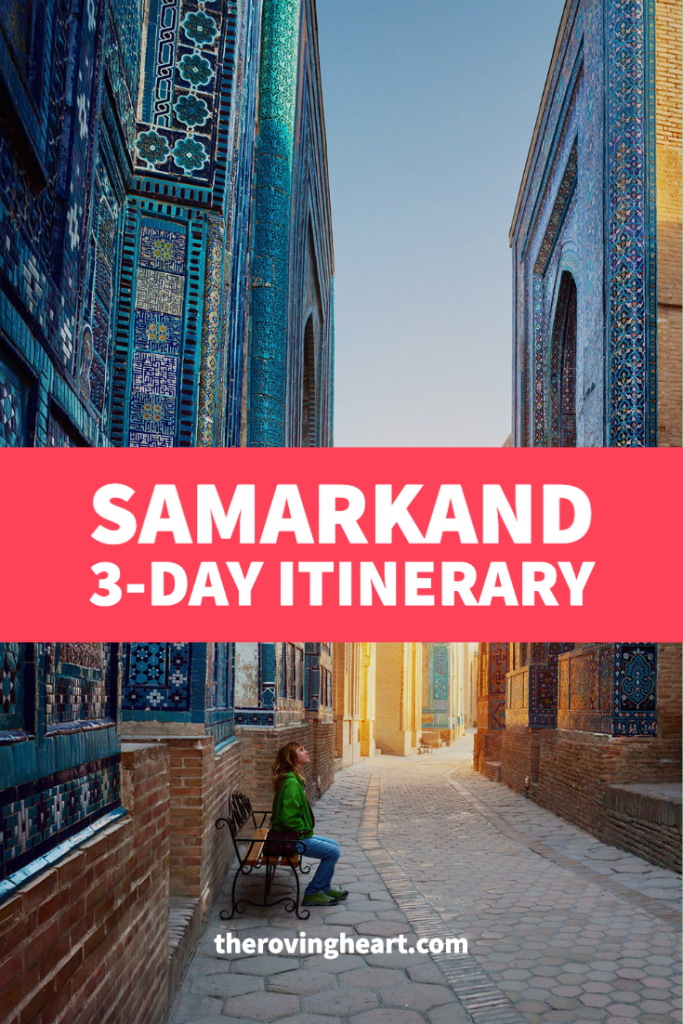











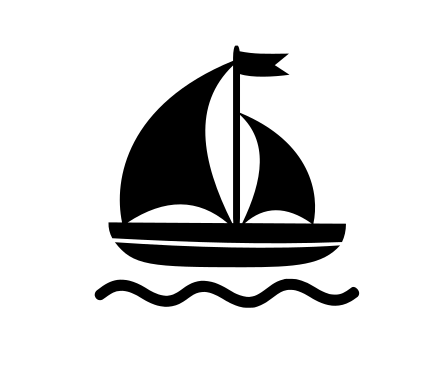




Comments
1 CommentAkansha
Jul 30, 2024It’s always a pleasure to read your blog. Thanks for sharing your knowledge with us!